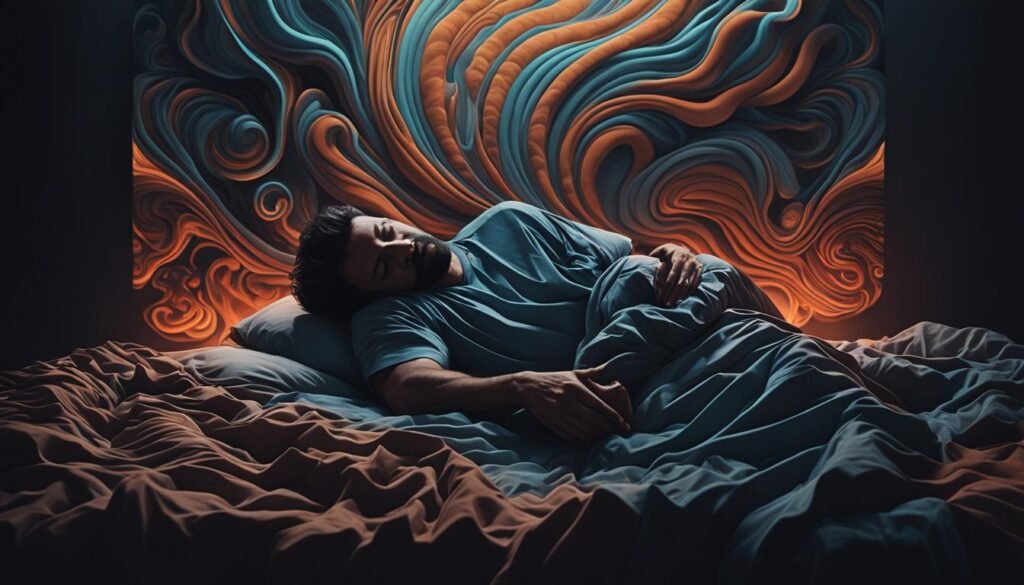Have you ever woken up feeling like someone is touching you while sleeping? Tactile hallucinations during sleep can be an unsettling experience, leaving you feeling confused and disturbed.
In this section, we will delve into the intriguing phenomenon of feeling like someone is touching you while sleeping. We will explore the concept of tactile hallucinations during sleep and discuss what might cause these sensory experiences.
Key Takeaways
- Tactile hallucinations during sleep can be a puzzling and unsettling experience.
- Feeling like someone is touching you while sleeping is a form of a tactile hallucination.
- Exploring the science behind sleep-related tactile hallucinations can help shed light on this phenomenon.
- Factors such as environmental conditions, sleep disorders, and psychological factors can influence sleep-related sensory experiences.
- Seeking professional help and implementing coping strategies can be beneficial for those experiencing sleep-related touch sensations.
Understanding Sleep-Related Body Sensations
As we sleep, our bodies continue to process information from the environment around us. This can result in a variety of sensory experiences during sleep, including touch, sound, and even smells. In this section, we will focus on sleep-related body sensations, examining the different types of tactile experiences that individuals may encounter while sleeping.
These sensations can range from the feeling of floating, vibrations, or pressure on different parts of the body, to the sensation of being hugged or held tightly. These experiences can originate from the brain’s interpretation of signals sent by the body or even the atmosphere.
It is essential to note that not all sensations felt during sleep are real; some are known as tactile hallucinations. These hallucinations can be the result of neurological disorders, medication, or other medical conditions.
Types of Sleep-Related Body Sensations
Here are some of the common types of sleep-related body sensations and how they may manifest as tactile hallucinations:
| Body Sensation | Manifestation as Tactile Hallucination |
|---|---|
| Pressure on the chest | Feeling like someone is sitting on or pressing down on the chest. |
| Touch on the arms or legs | Feeling like someone is stroking or touching the extremities or like they are being held. |
| Vibrations | Feeling a sensation of shaking or vibrations throughout the body. |
| Floaty feeling | Feeling like they are floating, levitating, or flying. |
It is important to note that these experiences can feel very real to the person experiencing them, even though they are not actually happening. We will explore sensory experiences during sleep further in the next sections.
Exploring Phantom Touch Sensations in Sleep
Phantom touch sensations during sleep are a unique and fascinating occurrence. These sensations refer to the feeling of being touched in sleep, even when there is no external stimulus present that could cause such a sensation. This experience can leave individuals feeling confused, alarmed, and curious about what is happening.
Several potential explanations may account for the sensation of being touched in sleep. One theory suggests that these sensations may be the result of an overactive brain attempting to interpret and process sensory information during sleep. Other theories propose that phantom touch sensations may be linked to sleep disorders such as sleep apnea or restless leg syndrome.
Phantom touch sensations in sleep have been a topic of interest for sleep researchers and clinicians. Recent studies have indicated a potential connection between phantom touch sensations and certain sleep disorders, such as periodic limb movement disorder. Further research is needed to fully understand the prevalence and underlying causes of these peculiar sleep-related experiences.
Individuals who experience phantom touch sensations in sleep may benefit from implementing changes in their sleep environment and practicing good sleep hygiene habits. It is also essential to consult with a healthcare provider if these sensations are causing significant distress or interfering with quality of life.
The Science Behind Sleep-Related Tactile Hallucinations
While the sensation of feeling touched during sleep may seem mysterious, scientists have been researching this phenomenon for years. Sleep-related tactile hallucinations typically occur during the hypnagogic or hypnopompic stages of sleep, which are periods of transition between wakefulness and sleep. Studies suggest that these experiences may be linked to a disruption in the body’s normal sensory processing. During sleep, the brain may misinterpret sensory signals from the body, leading to the sensation of being touched when no one is physically present.
One theory behind sleep-related tactile hallucinations involves changes in the normal functioning of the body’s somatosensory cortex, the part of the brain responsible for processing physical sensations. Researchers have found that this area of the brain can become more active during sleep, leading to the perception of tactile sensations even in the absence of any external stimuli. Other studies have explored the role of the neurotransmitter dopamine in tactile hallucinations during sleep, suggesting that imbalances in this chemical may contribute to these experiences.
“Sleep-related tactile hallucinations typically occur during the hypnagogic or hypnopompic stages of sleep, which are periods of transition between wakefulness and sleep.”
Despite ongoing research, much about sleep-related tactile hallucinations remains unknown. However, advancements in neuroscience and sleep medicine are shedding new light on this fascinating phenomenon and offering hope for future treatments.
Common Experiences of Touch While Sleeping
Experiencing touch sensations during sleep is a common occurrence that many people report. These sensations can vary widely in their nature from light touches to more firm sensations like a shake. But what causes these experiences? And why do some individuals experience them more frequently than others?
The range of potential touch sensations during sleep is vast, and can include being hugged or caressed, being tickled, or even being squeezed tightly. Individuals may also experience the sensation of something crawling on their skin, while others may feel like they are being poked or prodded. The intensity and frequency of these sensations may differ depending on the individual’s sleeping habits and the sleep cycle stage.
Several factors may contribute to touch sensations during sleep. Environmental factors such as the temperature of the sleeping area, the mattress and bedding quality, and lighting levels can all impact the likelihood of experiencing touch sensations during sleep.
Additionally, sleep disorders such as sleep deprivation, sleep apnea, and restless leg syndrome may also lead to touch sensations during sleep. Certain medications and psychological factors such as stress and anxiety may also contribute to the likelihood of experiencing touch sensations while sleeping.
It is worth noting that some touch sensations during sleep may be indicative of underlying medical conditions. Seek professional medical advice if these experiences prevent you from sleeping, or if you experience them frequently.
Factors That Influence Sleep-Related Sensory Experiences
Sleep-related tactile hallucinations or the feeling of being touched while asleep can be influenced by various factors. Understanding these factors can help individuals better manage their sleep-related sensory experiences.
Environmental Conditions
The sleep environment can greatly affect an individual’s sensory experiences during sleep. Factors such as room temperature, noise level, and lighting can influence the probability of experiencing tactile hallucinations during sleep. For instance, individuals who sleep in a noisy environment may be more likely to experience auditory hallucinations or buzzing sensations, while those who sleep in rooms with bright lights may experience visual hallucinations with greater frequency.
Sleep Disorders
Certain sleep disorders can contribute to the occurrence of tactile hallucinations during sleep. Sleep apnea, narcolepsy, and restless leg syndrome are examples of sleep disorders that can increase the likelihood of experiencing sleep-related touch sensations.
Medications
Medications can also influence sleep-related sensory experiences. Prescription drugs that can cause drowsiness or affect the sleep cycle, such as antidepressants and sedatives, may increase the frequency or intensity of tactile hallucinations during sleep.
Psychological Factors
Psychological factors can also contribute to the occurrence of tactile hallucinations during sleep. Stress, anxiety, and traumatic life events can increase the likelihood of experiencing sleep-related touch sensations. Additionally, individuals with certain mental health conditions, such as schizophrenia, may be more prone to experiencing tactile hallucinations during sleep.
“Understanding the factors that influence sleep-related sensory experiences can help individuals better manage their sleep-related tactile hallucinations and improve the quality of their sleep.”
Seeking Professional Help for Sleep-Related Touch Sensations
While sleep-related tactile hallucinations are relatively common, it is important to recognize when it may be necessary to seek professional help. If you are experiencing frequent or intense touch sensations during sleep that are interfering with your quality of life, it may be worth speaking with a healthcare provider.
There are a variety of potential underlying conditions or sleep disorders that could be causing these experiences, including narcolepsy, sleep apnea, and restless leg syndrome. If you are experiencing other symptoms in addition to tactile hallucinations, such as excessive daytime sleepiness or difficulty sleeping, it is particularly important to speak with a healthcare provider.
During an evaluation, a healthcare provider may conduct a physical examination and order diagnostic tests to help identify potential underlying causes. They may refer you to a sleep specialist or other healthcare professional if necessary.
In some cases, treatment may involve addressing an underlying condition or making lifestyle changes to improve sleep hygiene. In other instances, medication or other therapies may be recommended to manage symptoms and promote better overall sleep.
Coping Strategies for Sleep-Related Tactile Hallucinations
If you are experiencing sleep-related tactile hallucinations, you may feel alone, confused, or frightened. However, there are practical coping strategies that may help reduce the occurrence or intensity of these sensations. Below are some helpful tips:
1. Relaxation Techniques
Relaxation techniques such as deep breathing, meditation, and progressive muscle relaxation can be effective in reducing stress and anxiety that may contribute to the tactile hallucinations. Consider practicing these techniques before going to bed or during the day to promote overall relaxation.
2. Create a Comfortable Sleep Environment
Create a sleep-conducive environment that is dark, quiet, and cool. Consider using comfortable pillows and blankets to promote relaxation and reduce tension.
3. Practice Good Sleep Hygiene
Good sleep hygiene practices such as maintaining a consistent sleep schedule, avoiding caffeine and alcohol, and avoiding electronic devices before bed can help promote healthy, restful sleep.
4. Consult a Healthcare Provider
If your sleep-related tactile hallucinations are persistent or interfering with your daily life, consider consulting with a healthcare provider. They may recommend various treatments, such as cognitive-behavioral therapy, medications, or referral to a sleep specialist.
“It is essential to remember that seeking professional help when necessary and implementing coping strategies can be beneficial for those experiencing sleep-related touch sensations.”
Research and Advancements in Understanding Sleep-Related Sensations
Recent scientific research has made significant strides in our understanding of sleep-related tactile hallucinations. Research studies have documented that these sensations are more common among those who have experienced sleep-related disorders or irregularities in sleep patterns.
Neurochemical Mechanisms Behind Sleep-Related Sensations
Neurological studies have shown that sleep-related tactile hallucinations may result from irregularities in the transmission of neurotransmitters, particularly dopamine and norepinephrine. Certain medications, such as those used to treat Parkinson’s disease, may have an impact on these neurotransmitters and trigger tactile hallucinations during sleep.
New Insight into Sleep-Related Sensory Experiences
Recent research includes a study by Tiihonen et al. (2020) in which individuals were asked to describe their experiences of touch while sleeping. The study found that individuals reported various types of touch sensations, including pressure, squeezing, and even penetration.

Advancements in Diagnostic Tools
Advancements in diagnostic tools have also contributed to our understanding of sleep-related tactile hallucinations. Sleep studies and polysomnography can now monitor brain activity, muscle movement, and other factors that may contribute to these experiences.
Future Directions in Research
Future research will aim to elucidate the underlying cause of sleep-related tactile hallucinations and develop more targeted treatments. The findings of these studies may also shed light on other types of sensory experiences during sleep and their underlying neurobiological mechanisms.
Overall, ongoing research and advancements in our understanding of sleep-related sensations, including tactile hallucinations, have contributed significantly to our knowledge of these experiences.
Conclusion
In conclusion, sensations of touch while sleeping can be a perplexing experience that many individuals encounter. The sensory experiences during sleep can manifest as tactile hallucinations, leading to the feeling of someone touching you while sleeping.
By exploring the science of sleep-related tactile hallucinations and understanding the various factors that can influence these experiences, we hope to provide a comprehensive overview of this enigma. It is crucial to seek professional help when necessary and implement coping strategies such as relaxation techniques and sleep hygiene practices.
Research and advancements in understanding sleep-related sensations, including tactile hallucinations during sleep, are ongoing. Further studies and scientific findings can contribute to our knowledge of these experiences and help individuals who are struggling with these sensory experiences.
Overall, being informed about the feeling of being touched in sleep is essential in seeking help and finding ways to cope with these experiences. Sensory experiences during sleep are common, and with proper management, individuals can improve their quality of sleep and overall well-being.
SEO Relevant Keywords: feeling like someone is touching you while sleeping, sensory experiences during sleep.
FAQ
What are tactile hallucinations during sleep?
Tactile hallucinations during sleep refer to the sensation of feeling like someone is touching you while sleeping. These hallucinations are sensory experiences that occur during the sleep cycle and can manifest as various types of touch sensations on the body.
What might cause these sensations of touch while sleeping?
There is no definitive answer to what causes tactile hallucinations during sleep. However, they may be linked to sleep disorders such as sleep paralysis, parasomnias, or certain medications. Additionally, psychological factors, stress, and environmental conditions can contribute to these sensations.
What are some common experiences of touch while sleeping?
Common experiences of touch while sleeping can include a gentle stroke, a firm grip, or even a sensation of being pushed or pulled. Some individuals may also report feeling pressure, tingling, or the presence of insects crawling on the skin during sleep.
Are sleep-related tactile hallucinations a cause for concern?
In most cases, sleep-related tactile hallucinations are harmless and not a cause for concern. However, if these experiences significantly disrupt sleep, cause distress, or are accompanied by other symptoms, it may be advisable to consult a healthcare professional for further evaluation.
How can I cope with sleep-related touch sensations?
Coping strategies for sleep-related tactile hallucinations can include practicing good sleep hygiene, creating a soothing sleep environment, managing stress, and using relaxation techniques before bed. If these strategies are not effective, seeking professional help from a healthcare provider or sleep specialist may be beneficial.
Is there ongoing research on sleep-related sensations?
Yes, there is ongoing research on sleep-related sensations, including tactile hallucinations. Scientists are continually advancing our understanding of these phenomena through studies on sleep disorders, the brain, and various sensory experiences during sleep.



